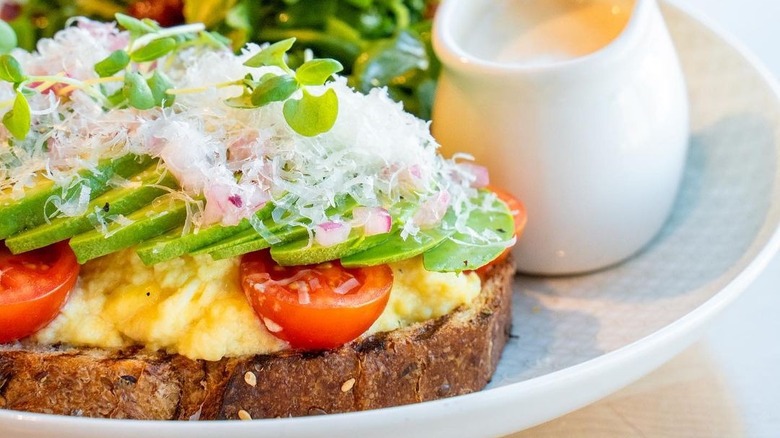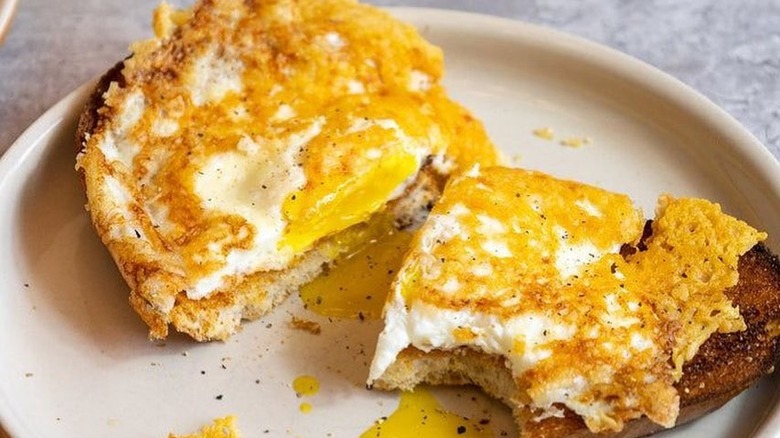Giada De Laurentiis' Cacio E Pepe Eggs Are A Must-Try For Brunch
Leftover pasta from the night before can sometimes hit the spot the next morning, but most people don't whip up a fresh batch of cacio e pepe for breakfast. Giada De Laurentiis, however, has other ideas as one of her favorite dishes, cacio e pepe, has earned not one but two spots on the menu at her Las Vegas restaurant as both a brunch and dinner entrée. For dinner, De Laurentiis serves a more traditional version featuring bucatini pasta, but she turns the classic Italian dish into scrambled eggs for brunch.
It might seem odd initially to turn a pasta dish into a breakfast food, but cacio e pepe simply means "cheese and pepper" in Italian, ingredients that are no stranger to scrambled eggs. In traditional cacio e pepe, a combination of pecorino and either parmesan or Grana Padano make up the cheese component of the dish, while freshly ground black pepper, along with salt and butter, brings it all together. Though scrambled eggs don't normally call for dry-aged cheese, De Laurentiis's recipe proves it's a tasty addition.
How to make Giada De Laurentiis's cacio e pepe scrambled eggs
Giada De Laurentiis shares many recipes, but her restaurant's cacio e pepe scrambled eggs isn't one of them. Luckily, the celebrity chef once demonstrated how she makes scrambled eggs in an early season of her Food Network show "Everyday Italian." She starts by whisking eggs with salt, pepper, and cheese while orzo cooks in a separate pot. In the episode, De Laurentiis used mozzarella, but for her cacio e pepe eggs, we can only assume she opted for parmesan and pecorino, the cheeses she normally puts in her regular cacio e pepe. Once these ingredients were whisked together, she melted butter in a pan over medium heat and scrambled the eggs with the cooked orzo. After about four minutes, it was ready to serve.
At her restaurant, De Laurentiis's cacio e pepe eggs are served on a slice of toast and topped with avocado, cherry tomatoes, diced red onions, and shredded cheese. The brunch entrée is also served with a small salad, but if you're making it at home and want to preserve the simple flavors of a traditional cacio e pepe, this egg version can be just as delicious by itself.
It works with fried eggs too
If you prefer fried eggs rather than scrambled, it's still possible to enjoy them cacio e pepe style. According to Giada De Laurentiis's blog, the main ingredients are the same, but the cooking process and results are slightly different. Instead of whisking together the eggs, cheese, and pepper, they get added to the pan individually. The pecorino and parmesan go in first, and when it melts, you crack in the eggs. By the time the edges of the eggs are cooked, the cheese will have crisped up, and only then do you add the pepper, salt, and extra cheese. Depending on how runny you like the yolk, at this point, you can either flip the eggs or take them off the stove.
Unlike De Laurentiis's cacio e pepe pasta and cacio e pepe scrambled eggs, this fried egg version is crispy rather than creamy, but it still has all the same flavors. You can serve it how you normally serve fried eggs, or, per Laurentiis's recommendation, you can eat it with a piece of toast and an arugula salad.


